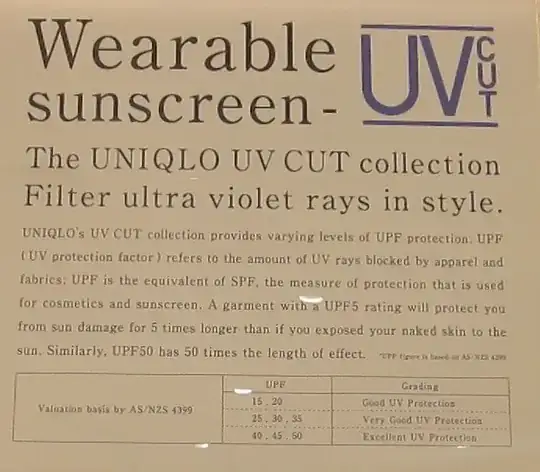Clever marketing gimmick if you live in northern climes (where I have seen this marketed), but of value in hotter climates. Basically cloth will stop/absorb UV radiation based on the weave density. No one wearing a flannel shirt will ever get burned. However, it is not practical to wear such thick clothing in the summer or hot climates. So if UV absorbent chemicals are added, it will offer additional protection without the necessary bulk. Valuable in tropical climates.
The skin cancer foundation actually does recommend this type of clothing on their site. As I said
Clothes can protect your skin against the sun's harmful ultraviolet (UV) rays. But not all clothing is created equal. The tightness of the weave, the weight, type of fiber, color and amount of skin covered all affect the amount of protection they provide.
And they even offer a couple examples
As a rule, light-colored, lightweight and loosely-woven fabrics do not offer much protection from the sun. That white T-shirt you slip on at the beach when you feel your skin burning provides only moderate protection from sunburn, with an average ultraviolet protection factor (UPF) of 7. At the other end of the spectrum, a long-sleeved dark denim shirt offers an estimated UPF of 1,700 – which amounts to a complete sun block. In general, clothing made of tightly-woven fabric best protects skin from the sun. The easiest way to test if a fabric can protect your skin is to hold it up to the light. If you can see through it, then UV radiation can penetrate it – and your skin.
Their recommendation is as expected from this
To receive The Skin Cancer Foundation's Seal of Recommendation, sun-protective fabrics must have a minimum UPF of 30. We consider a UPF rating of 30-49 to offer very good protection, and 50+ excellent protection.
The New York University School of Medicine actually did a study to back up the Skin Cancer foundation. I added emphasis on the final conclusion.
Abstract
BACKGROUND: The public has long been instructed to wear protective clothing against ultraviolet (UV) damage.
OBJECTIVE: Our purpose was to determine the UV protection factor (UPF) of two cotton fabrics used in the manufacture of summer T-shirts and to explore methods that could improve the UPF of these fabrics.
METHODS: Each of the two types of white cotton fabrics (cotton T-shirt and mercerized cotton print cloth) used in this study was divided into 4 treatment groups: (1) water-only (machine washed with water), (2) detergent-only (washed with detergent), (3) detergent-UV absorber (washed with detergent and a UV absorber), and (4) dyes (dyed fabrics). Ultraviolet transmission through the fabrics was measured with a spectrophotometer before and after laundry and dyeing treatments. Based on UV transmission through these fabrics, the UPF values were calculated.
RESULTS: Before any treatments, the mean UPFs were 4.94 for the T-shirt fabric and 3.13 for the print cloth. There was greater UVA (320-400 nm) than UVB (280-320 nm) transmission through these fabrics. After 5 washings with water alone and with detergent alone, UPF increased by 51% and 17%, respectively, for the cotton T-shirt fabric. Washing the T-shirt fabrics with detergent plus the UV-absorbing agent increased the UPF by 407% after 5 treatments. Dyeing the fabric blue or yellow increased the UPF by 544% and 212%, respectively. Similar changes in UPFs were observed for the print cloth fabric.
CONCLUSION: The two cotton fabrics used in this study offered limited protection against UV radiation as determined by spectrophotometric analysis. Laundering with detergent and water improves UPF slightly by causing fabric shrinkage. Dyeing fabrics or adding a UV-absorbing agent during laundering substantially reduces UV transmission and increases UPF. More UVA is transmitted through the fabrics than UVB.
